Welcome to my article comparing two delicious tropical fruits: pulasan and rambutan. These exotic fruits often draw comparisons due to their similarities in appearance and taste. As an avid fruit enthusiast, I have discovered some interesting differences between these two fruits that set them apart. Join me on a journey exploring the unique flavors and characteristics of pulasan and rambutan.
Native to Malaysia and the Philippines, pulasan is a rare and highly sought-after fruit. With its larger size, thicker skin, and sweeter taste, pulasan is a tropical treat that will tantalize your taste buds. On the other hand, rambutan, native to Indonesia and Malaysia, boasts a distinctive spiky red exterior and a slightly tart flavor that resembles grapes. These two fruits may have some similarities, but they offer a unique taste experience.
In this article, we will delve into the differences between pulasan and rambutan, including their appearance, taste, nutritional benefits, and even how to enjoy them. By the end, you’ll have a deeper understanding of these tropical delights and perhaps be inspired to seek them out and indulge in their exotic flavors.
Key Takeaways:
- Pulasan and rambutan are exotic tropical fruits with similarities in appearance and taste.
- Pulasan is larger and sweeter than rambutan, while rambutan has a slightly tart flavor.
- Both fruits offer nutritional benefits and can be enjoyed in various culinary preparations.
- Growing pulasan and rambutan requires a warm and humid climate with well-drained soil.
- Exploring the flavors of pulasan and rambutan is a delightful way to experience the diverse range of tropical fruits.
Pulasan Fruit
Pulasan fruit, scientifically known as Nephelium mutabile, is a rare and exotic fruit native to Malaysia and the Philippines. It is highly sought after for its unique flavor, distinctive appearance, and a range of health benefits it offers.
The pulasan fruit is larger than its cousin, the rambutan, and has a thicker, softer skin that is slightly harder to peel. The skin can be described as a combination of green and reddish-brown with hair-like protrusions.
When you open the pulasan fruit, you will find the sweet, translucent flesh that is slightly juicy. Many people describe the taste of pulasan as even sweeter than rambutan, with hints of tropical flavors that are truly delightful.
One of the unique features of pulasan is that its seeds are edible. The seeds have a taste similar to almonds, and some people enjoy eating them along with the flesh or use them in various culinary preparations.
For all the fruit enthusiasts, growing pulasan trees in tropical climates can be a rewarding experience. These trees are relatively easy to grow and maintain. They require well-drained soil, plenty of sunlight, and regular watering to thrive.
Once matured, pulasan trees produce an abundant harvest of these delectable fruits that are highly prized for their exceptional taste and texture.
Rambutan
Rambutan, scientifically known as Nephelium lappaceum, is a fruit native to Indonesia and Malaysia. It is smaller than pulasan and has a red, spiky skin that gives it a unique appearance. The flesh of rambutan is also sweet and juicy, similar to pulasan, but the taste is often described as slightly tart and more grape-like.
Rambutan is rich in vitamin C and other nutrients, making it a healthy choice. It is also a good source of antioxidants, which can help protect the body against free radicals and support overall health. Including rambutan in your diet can provide a boost of essential vitamins and minerals.
To enjoy a rambutan, start by peeling off the skin using your fingers or a knife. Once the skin is removed, you’ll find the juicy flesh inside. Remove the seed, as it is not edible, and savor the sweet and tangy flavor of the fruit.
Rambutan Nutrition
| Nutrient | Amount per 100g |
|---|---|
| Calories | 69 |
| Protein | 0.9g |
| Fat | 0.2g |
| Carbohydrates | 16.5g |
| Fiber | 0.9g |
| Vitamin C | 20.9mg |
| Calcium | 9mg |
| Potassium | 42mg |
Rambutan is a low-calorie fruit, making it a guilt-free snack option. It is packed with vitamin C, which supports immune function and acts as an antioxidant in the body. Additionally, rambutan is a good source of fiber, which aids in digestion and promotes a healthy gut. Incorporating rambutan into your diet can be a delicious way to nourish your body and indulge in tropical flavors.
Appearance and Taste
When it comes to appearance, both pulasan and rambutan share a similar round shape and spiky skin, but there are subtle differences that set them apart.
Pulasan has a thicker, softer, and less pronounced hair-like covering compared to rambutan. The skin of pulasan varies in color, ranging from red to reddish-black. On the other hand, rambutan typically has a red skin, although it can also be found in yellow or orange varieties.
Now, let’s talk about the taste. Pulasan is often considered sweeter than rambutan, with a slightly juicier flesh. Its sweetness is often described as luscious and indulgent, making it a delightful tropical treat. In contrast, rambutan offers a slightly tart taste that is often likened to grapes. It provides a balance between sweetness and a tangy kick, offering a unique flavor experience.
Overall, both pulasan and rambutan provide a refreshing and tropical flavor experience that is sure to delight fruit enthusiasts.
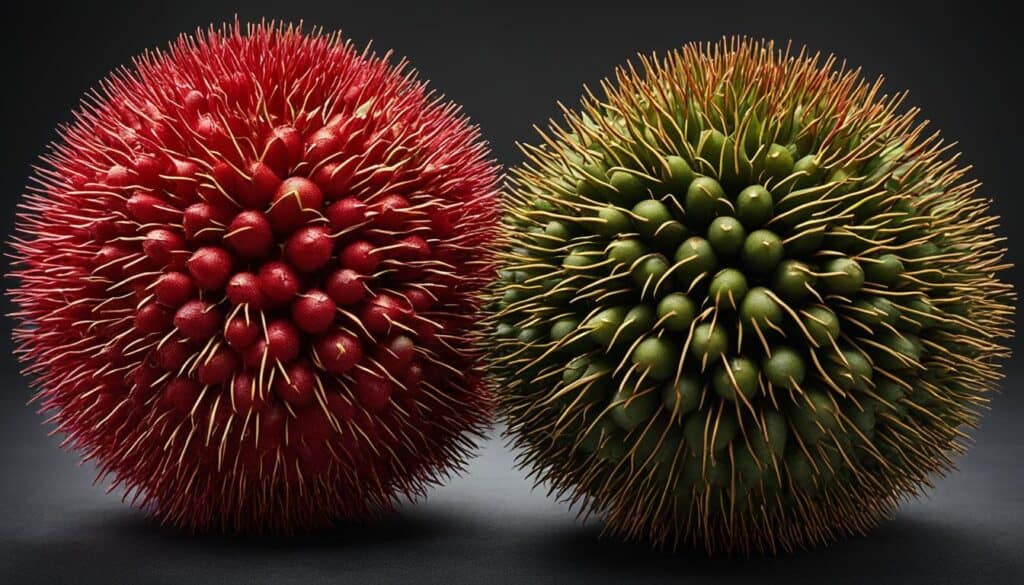
Nutritional Benefits
Both pulasan and rambutan offer several nutritional benefits. They are both low in calories and fat, making them a healthy snack option.
Pulasan is rich in essential nutrients such as vitamin C, vitamin A, and fiber. It also contains antioxidants that can help protect against oxidative stress and inflammation.
Rambutan is also a good source of vitamin C, providing more than the recommended daily intake in just a few fruits. Additionally, rambutan contains iron, calcium, and other vitamins and minerals that contribute to overall health.
| Pulasan | Rambutan |
|---|---|
| Low in calories and fat | Low in calories and fat |
| Rich in vitamin C, vitamin A, and fiber | Rich in vitamin C, iron, calcium, and other minerals |
| Contains antioxidants | Contains antioxidants |
How to Eat Pulasan and Rambutan
Eating pulasan and rambutan is a simple process that allows you to savor the unique flavors of these exotic fruits. Let me guide you through how to enjoy these tropical delights.
How to Eat Pulasan
To indulge in the sweetness of pulasan, start by using your thumbs to gently pry open the leathery skin. As you peel it away, the white, translucent flesh will be revealed. You can either pop a pulasan fruit directly into your mouth or bite into it while holding it in your hand. Take note that the seeds of pulasan are edible and have a delightful almond-like taste, adding a bit of crunch to your experience.
How to Eat Rambutan
When it comes to eating rambutan, there’s a simple technique to get to the juicy flesh. Begin by peeling off the skin, which can be done by scoring it with a knife or using your fingers. Once the skin is removed, the vibrant and juicy fruit awaits you. The seed should be discarded, enabling you to fully enjoy the deliciousness of the rambutan’s flesh.
Now that you know the art of indulging in the flavors of pulasan and rambutan, go ahead and enjoy these tropical treasures to the fullest.
Growing Pulasan and Rambutan
As tropical fruits, pulasan and rambutan thrive in warm and humid climates. These fruits prefer well-drained soil and require plenty of sunlight to grow. While pulasan trees can reach up to 82 feet in height, rambutan trees are slightly smaller, averaging around 49 feet.
For optimal growth, pulasan trees need deep and fertile soil, while rambutan trees thrive in well-drained soil with good organic content. Both fruits can be propagated through seeds or grafting.
To ensure healthy growth and abundant fruit production, regular watering and fertilization are essential for both pulasan and rambutan trees.
Tropical Fruit Tree Comparison:
| Characteristics | Pulasan | Rambutan |
|---|---|---|
| Tree Height | Up to 82 feet | Around 49 feet |
| Soil Requirements | Deep and fertile | Well-drained with good organic content |
| Propagation | Seeds or grafting | Seeds or grafting |
| Watering | Regular watering | Regular watering |
| Fertilization | Regular fertilization | Regular fertilization |
I have found that growing pulasan and rambutan trees can be a rewarding experience. The lush foliage and delicious fruits are a testament to the tropical paradise they thrive in.
With the right conditions and care, you can enjoy an abundant harvest of pulasan and rambutan, bringing the taste of the tropics right to your doorstep.
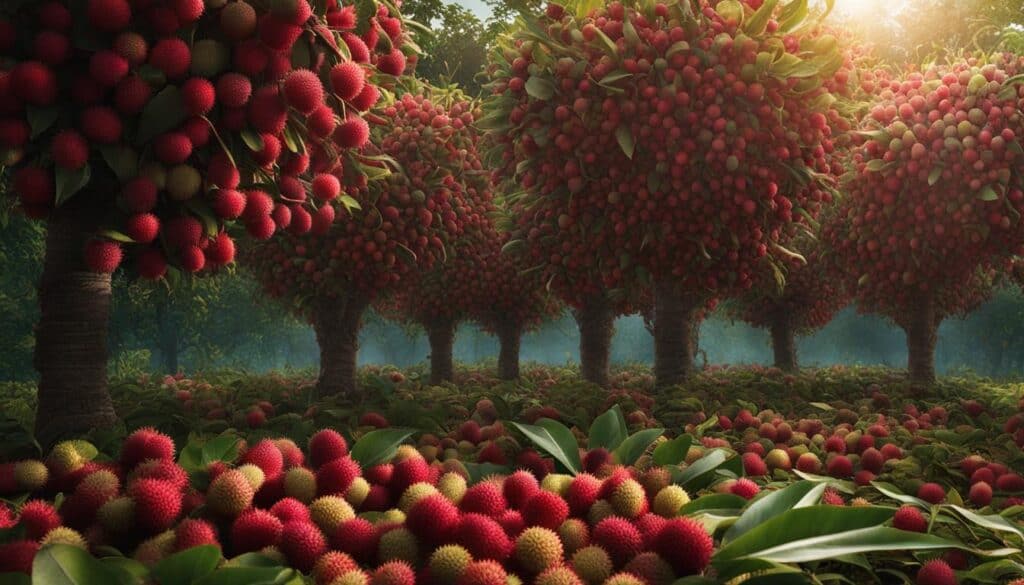
Remember to provide well-drained soil, ample sunlight, regular watering, and fertilization to help these tropical fruit trees flourish in your own backyard.
Other Exotic Asian Fruits
Asia is home to a wide variety of exotic fruits. In addition to pulasan and rambutan, there are several other tantalizing options to explore. Let’s take a closer look at some popular Asian fruits:
Asian Pear
Asian pear, sometimes referred to as Chinese or Korean pear, is a delightful fruit with a crisp texture and a flavor that combines the best of both apples and pears. Its juicy flesh and refreshing taste make it a favorite snack among fruit lovers.
Jackfruit
Jackfruit holds the title for being the largest fruit in the world and boasts a sweet and tropical taste. Its unique texture adds a delightful twist to both savory and sweet dishes, making it a versatile ingredient in Asian cuisines.
Durian
Durian, famously known for its strong aroma, is a fruit with a creamy and delicious flesh. Its flavor profile is often described as a combination of sweet, savory, and custard-like, making it a unique and memorable experience for adventurous eaters.
Lychee
Lychee is a small, round fruit with a fragrant and sweet flavor. Its delicate flesh is juicy and translucent, providing a refreshing burst of tropical goodness. It’s a popular ingredient in desserts, cocktails, and refreshing summer salads.
Dragon Fruit
Dragon fruit, with its vibrant appearance, is as pleasing to the eyes as it is to the palate. Its mildly sweet taste and refreshing texture resemble a cross between melon and kiwi. It’s often enjoyed fresh or used as an ingredient in smoothies, salads, and desserts.
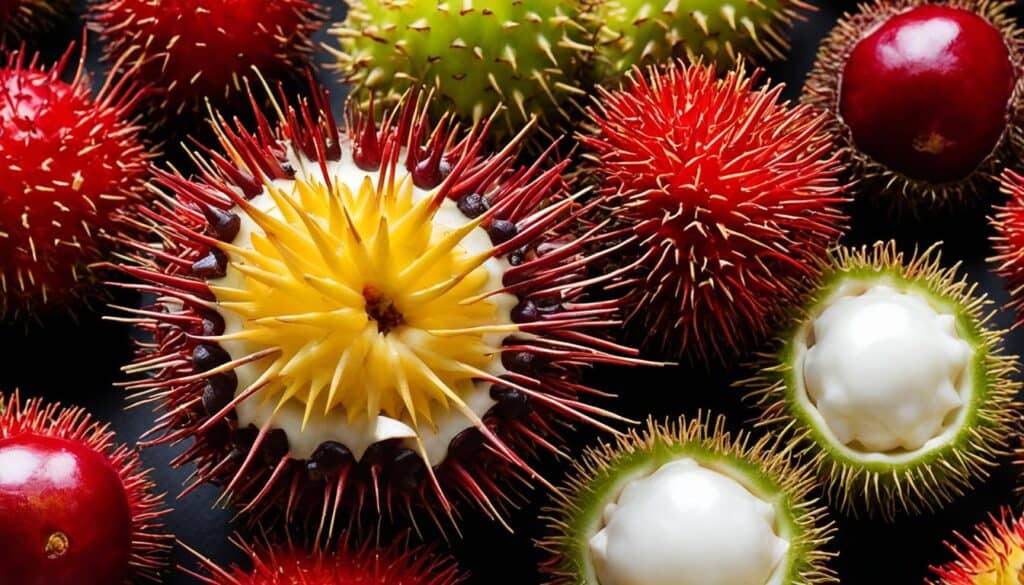
| Fruit | Appearance | Taste |
|---|---|---|
| Asian Pear | Rounded shape with a yellow or brown skin | Combination of apple and pear |
| Jackfruit | Large, spiky exterior with yellowish flesh | Sweet and tropical |
| Durian | Thorn-covered exterior with creamy, pale yellow flesh | Strong and custard-like |
| Lychee | Small, round fruit with a rough, red skin | Fragrant and sweet |
| Dragon Fruit | Bright pink or yellow skin with green scales | Mild and reminiscent of melon or kiwi |
These exotic Asian fruits offer a wide range of flavors and textures, adding excitement and variety to your fruit repertoire. Incorporating them into your meals and snacks can provide a taste of the tropics and a journey through the vibrant flavors of Asia.
Pulasan and Rambutan in Popular Asian Cuisines
Pulasan and rambutan are not only enjoyed as fresh fruits, but they also play a significant role in various Asian cuisines. These tropical fruits add a unique flavor and texture to a wide range of dishes, making them versatile ingredients that can enhance both sweet and savory culinary creations.
In Thailand, pulasan and rambutan are popularly used in salads, desserts, and beverages. The sweet and juicy flesh of these fruits adds a refreshing and tropical taste to these dishes, creating a delightful combination of flavors.
“The inclusion of pulasan and rambutan in Thai cuisine adds a burst of sweetness and juiciness to the dishes, complementing the other ingredients and creating a harmonious flavor profile.”
In Malaysia and Indonesia, rambutan takes center stage in traditional dishes, particularly in curries and desserts. The slightly tart taste of rambutan adds a tangy note that beautifully balances the rich and aromatic flavors of these dishes.
“Rambutan, with its unique taste and vibrant appearance, is often used as a key ingredient in curries and desserts in Malaysian and Indonesian cuisines, adding both flavor and visual appeal.”
Whether it’s a colorful fruit salad, a refreshing sorbet, or a spicy curry, pulasan and rambutan bring a touch of tropical indulgence to Asian cuisines. Their vibrant flavors and juicy textures make them sought-after ingredients among chefs and home cooks alike.
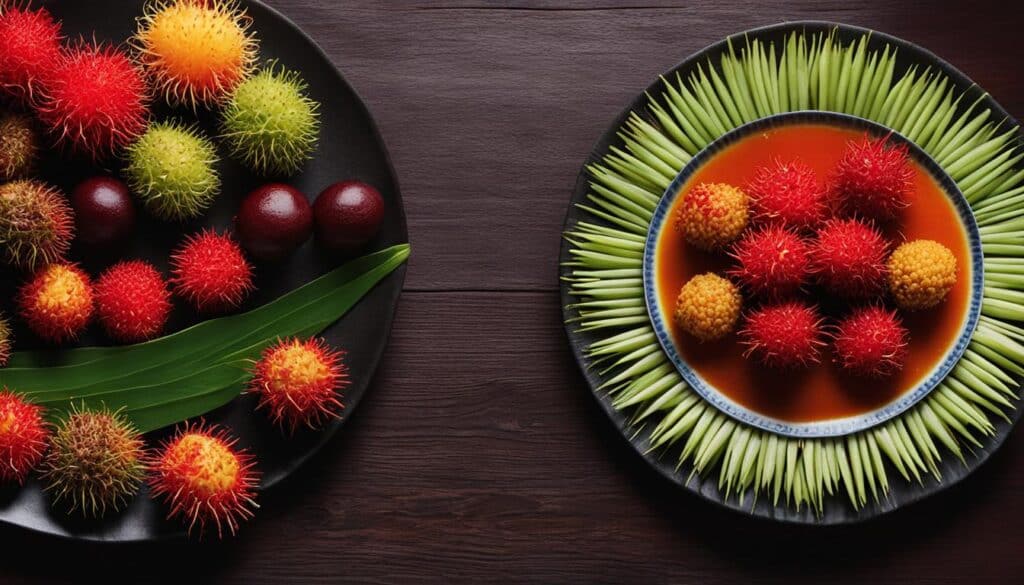
Explore the Culinary Possibilities
If you’re feeling adventurous in the kitchen, consider incorporating pulasan and rambutan into your culinary repertoire. Here are some exciting ways to use these exotic fruits:
- Add pulasan or rambutan to tropical fruit salads for a burst of sweetness.
- Create a refreshing pulasan or rambutan sorbet by blending the fruits with ice and a touch of sugar.
- Make a pulasan or rambutan smoothie by blending the fruits with yogurt and a splash of coconut milk.
- Include pulasan or rambutan in traditional Thai desserts like sticky rice with mango or coconut milk-based desserts.
- Experiment with rambutan in curry dishes for a unique twist on traditional recipes.
The culinary uses of pulasan and rambutan are limited only by your imagination. Don’t be afraid to get creative and explore the numerous possibilities that these exotic fruits offer in the kitchen.
Health Benefits of Exotic Asian Fruits
Exotic Asian fruits like pulasan and rambutan not only tantalize the taste buds but also offer a plethora of health benefits. These fruits are packed with antioxidants, which play a crucial role in protecting the body against harmful free radicals and reducing the risk of chronic diseases.
Antioxidants are powerful compounds that neutralize free radicals, unstable molecules that can damage cells and contribute to aging and diseases such as cancer, heart disease, and inflammatory conditions. By incorporating pulasan and rambutan into your diet, you can boost your antioxidant intake and enhance your body’s defense against oxidative stress.
In addition to antioxidants, these exotic fruits also provide a rich array of essential vitamins and minerals. Pulasan and rambutan are abundant in vitamin C, a vital nutrient for immune function and collagen synthesis. Vitamin C supports the body’s natural defense system, helping to ward off infections and promote wound healing.
Moreover, both pulasan and rambutan are excellent sources of dietary fiber, which aids in healthy digestion, prevents constipation, and supports weight management. Fiber is also beneficial for maintaining stable blood sugar levels and reducing the risk of type 2 diabetes.
Let’s take a closer look at the key health benefits offered by these exotic Asian fruits:
| Pulasan | Rambutan |
|---|---|
| High in antioxidants, including polyphenols and flavonoids, which combat oxidative stress | Rich in vitamin C, a potent antioxidant that supports immune function |
| Good source of dietary fiber, promoting healthy digestion | Contains iron and calcium, essential minerals for strong bones and blood health |
| Provides vitamin A, which is crucial for eye health and immune function | Loaded with vitamin C, exceeding the recommended daily intake in just a few fruits |
By incorporating these exotic fruits into your diet, you can enjoy their mouthwatering flavors while reaping their numerous health benefits. Whether enjoyed fresh, added to salads or smoothies, or used in delectable desserts, pulasan and rambutan are a delightful addition to any well-rounded diet.
So why not give these exotic Asian fruits a try and savor the unique blend of deliciousness and well-being they offer?
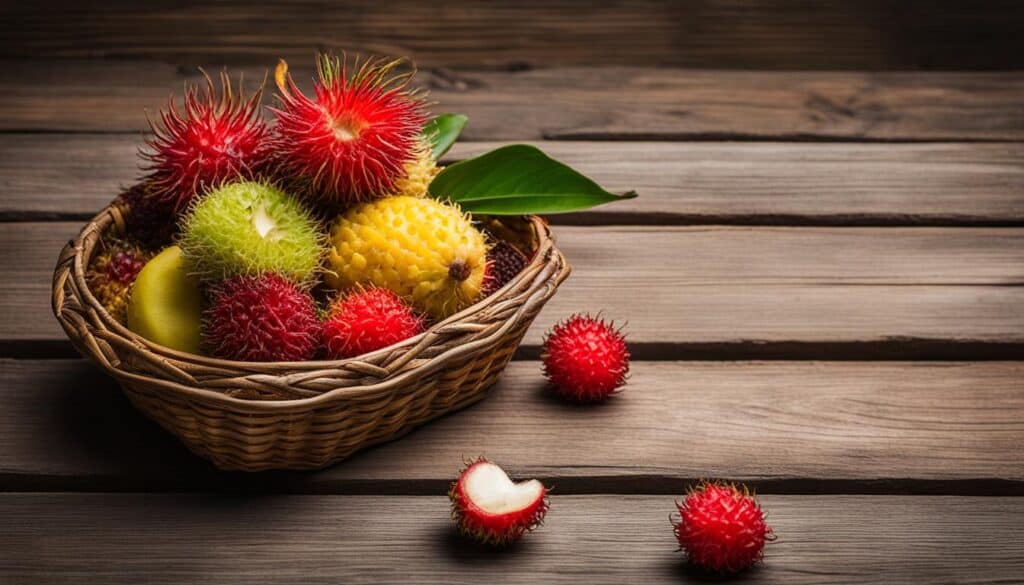
Note: Always consult with a healthcare professional before making significant changes to your diet or if you have any specific health concerns.
Experiencing the Exotic
Exploring the world of exotic fruits is a delightful culinary adventure. The unique flavors and textures of fruits like pulasan and rambutan offer a taste of the tropics and an opportunity to expand your palate. Whether you encounter these fruits while traveling in Southeast Asia or find them at specialty markets, don’t hesitate to give them a try. Experiencing exotic fruits like pulasan and rambutan allows you to indulge in the vibrant flavors of Asia and discover the wonders of these tropical treasures.
With their contrasting appearances and distinct flavors, pulasan and rambutan are sure to captivate your taste buds and leave a lasting impression. While pulasan entices with its exotic sweetness and slightly crunchy texture, rambutan surprises with its refreshing tartness and juicy flesh. Trying these unique fruits opens up a world of flavors that can transport you to distant lands and provide a truly memorable experience.
When you savor the exquisite taste of pulasan and rambutan, you not only satisfy your cravings but also connect with the cultural richness of Southeast Asia. The locals have been enjoying these exotic fruits for generations, incorporating them into traditional dishes and transforming them into delightful desserts and beverages. By embracing these fruits, you get a glimpse of the culinary traditions and flavors that make Asian cuisine so enchanting.
Conclusion
In conclusion, pulasan and rambutan are two exotic fruits that offer a delightful taste of the tropics. While they share similarities in their sweet and juicy flesh, there are distinct differences that make each fruit unique. Pulasan is known for its sweeter taste and edible seeds, while rambutan has a slightly tart flavor and a spikier appearance.
Both pulasan and rambutan provide nutritional benefits, making them a healthy addition to your diet. They can be enjoyed in various culinary preparations, adding a tropical twist to your meals and desserts. Exploring the flavors of these fruits is an exciting experience that introduces you to the rich diversity of tropical fruits.
So, next time you come across pulasan and rambutan, don’t hesitate to give them a try and indulge in their exotic taste. Whether you enjoy them fresh or use them in recipes, these fruits are sure to impress your taste buds and offer a unique culinary adventure!
FAQ
What is the difference between pulasan and rambutan?
Pulasan is larger than rambutan and has a thicker, softer skin. Pulasan is also sweeter and has edible seeds, while rambutan has a slightly tart taste and spikier appearance.
How do pulasan and rambutan taste?
Pulasan is often described as sweeter and slightly juicier than rambutan. Rambutan has a slightly tart taste that is likened to grapes.
What are the nutritional benefits of pulasan and rambutan?
Pulasan is rich in essential nutrients such as vitamin C, vitamin A, and fiber, while rambutan is a good source of vitamin C, iron, calcium, and other vitamins and minerals.
How do you eat pulasan and rambutan?
To eat pulasan, gently pry open the leathery skin with your thumbs and enjoy the sweet, translucent flesh. The seeds are also edible. To eat rambutan, peel off the skin and remove the seed, then enjoy the juicy flesh.
How do you grow pulasan and rambutan?
Pulasan and rambutan trees thrive in warm and humid climates. They require well-drained soil, plenty of sunlight, regular watering, and fertilization for optimal growth and fruit production.
What are some other exotic Asian fruits?
Asian pear, jackfruit, durian, lychee, and dragon fruit are popular Asian fruits with unique flavors and textures.
How are pulasan and rambutan used in Asian cuisines?
In Thailand, pulasan and rambutan are used in salads, desserts, and beverages. In Malaysia and Indonesia, rambutan is often used in traditional dishes, especially in curries and desserts.
What are the health benefits of exotic Asian fruits?
Exotic Asian fruits like pulasan and rambutan are rich in antioxidants, vitamins, and minerals, which support immune function, promote healthy digestion, and contribute to overall well-being.
How can I experience the exotic flavors of pulasan and rambutan?
You can try pulasan and rambutan either while traveling in Southeast Asia or by finding them at specialty markets. Enjoy their unique taste and indulge in the vibrant flavors of Asia.

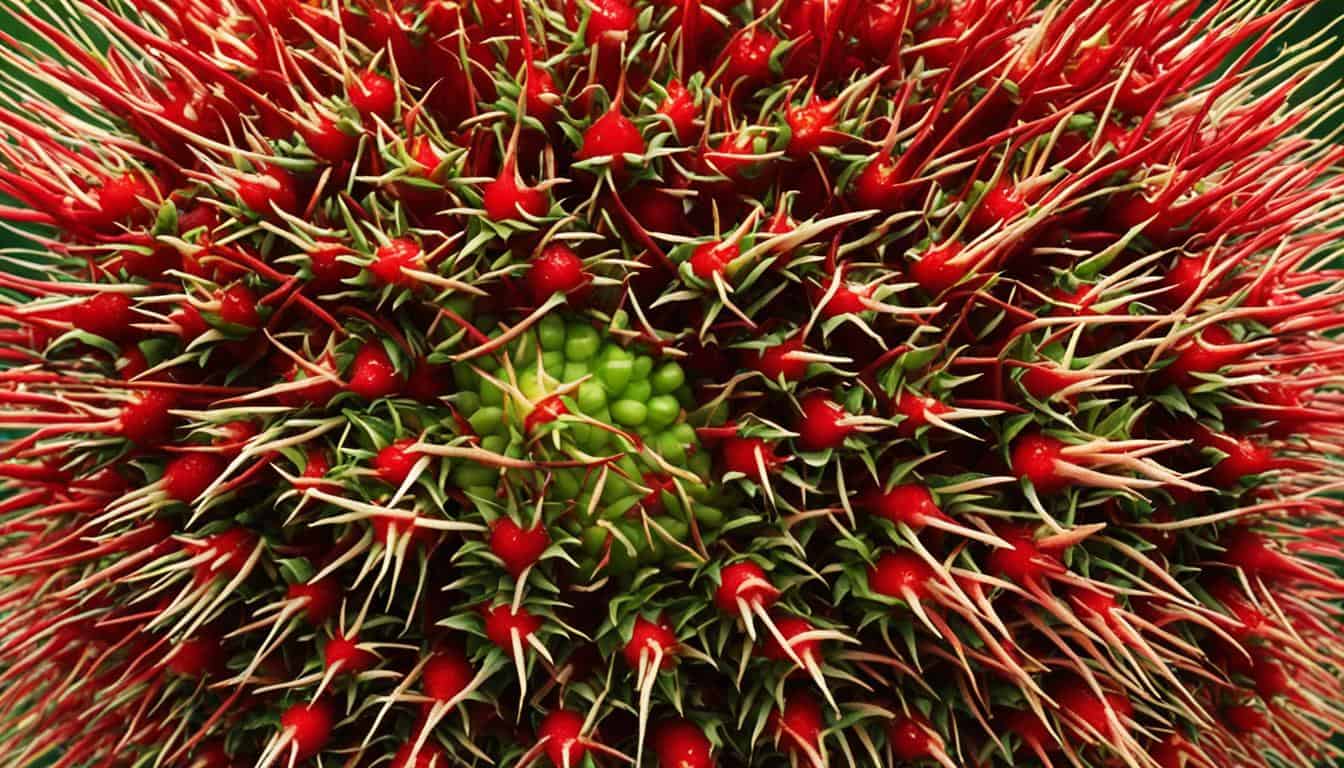



Leave a Reply